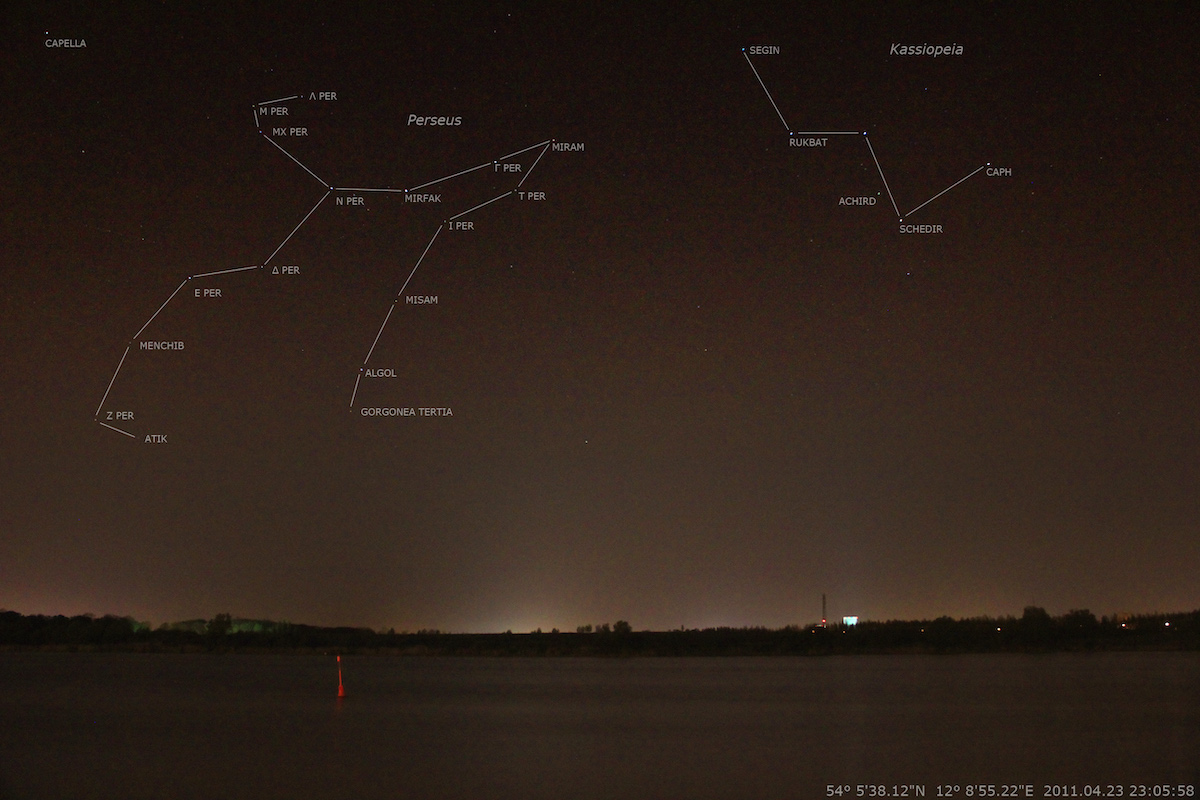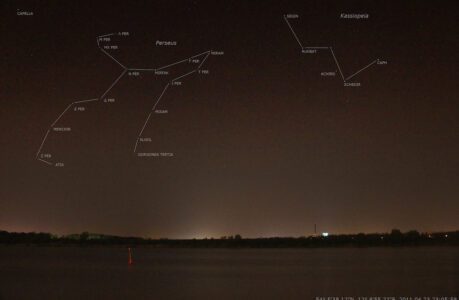The Perseus constellation is one of the most recognizable patterns of stars in the night sky. Named after the Greek hero who slayed the Gorgon Medusa, this constellation is home to many bright stars, including the famous variable star Algol. If you are in Ireland and want to explore the wonders of the Perseus constellation, here is a guide to help you get started.
The Perseus Constellation
The Perseus constellation is located in the northern hemisphere and can be seen from Ireland throughout the year. It is a part of the Perseus family of constellations that includes Andromeda, Cassiopeia, and Pegasus. The constellation is easily recognizable due to its shape that resembles a sideways ‘Y’. The brightest star in Perseus is Mirfak, which is also known as Alpha Persei. Mirfak is located at the bottom of the ‘Y’ shape and has a magnitude of 1.8, making it easily visible to the naked eye.
Mythology of Perseus
In Greek mythology, Perseus was the son of Zeus and the mortal woman Danae. He was known for his heroic deeds, including slaying the Gorgon Medusa and rescuing Andromeda from a sea monster. The Perseus constellation was named after him as a tribute to his bravery and courage.
Notable Stars in Perseus
Perseus is home to several bright stars, including Algol, which is one of the most famous variable stars in the sky. Algol is located at the head of Medusa, the Gorgon slain by Perseus. It is also known as the Demon Star because of its variability, which causes it to periodically dim and brighten. Other notable stars in Perseus include:
- Mirfak (Alpha Persei): The brightest star in Perseus, located at the bottom of the ‘Y’ shape.
- Menkib (Xi Persei): A blue-white star located near the center of the ‘Y’ shape.
- Atik (Omicron Persei): A binary star system located at the top of the ‘Y’ shape.
Best Time to Observe Perseus
The Perseus constellation can be seen from Ireland throughout the year, but the best time to observe it is during the winter months. This is when the constellation is at its highest point in the sky, making it easier to see. The best time to observe Perseus is between midnight and dawn, when the sky is at its darkest.
How to View Perseus from Ireland
To view the Perseus constellation from Ireland, you will need to find a location with minimal light pollution. This could be a park or countryside area away from city lights. Once you have found a suitable location, wait until the sky is dark, and look towards the northeast. The Perseus constellation will be visible near the horizon.
If you have a pair of binoculars or a telescope, you can get a closer look at the stars in Perseus. Algol, in particular, is an interesting star to observe due to its variability. You can use a star chart or a mobile app to help you identify the stars in the constellation and navigate the night sky.
In ConclusionThe Perseus constellation is a fascinating pattern of stars that can be observed from Ireland throughout the year. With its notable stars and mythology, Perseus is a must-see for stargazers and astronomy enthusiasts.
How can I see the constellation of Perseus from Ireland?
To see the constellation of Perseus from Ireland, you will need to find a location with minimal light pollution, such as a park or countryside area away from city lights. Once you have found a suitable location, wait until the sky is dark, and look towards the northeast. The Perseus constellation will be visible near the horizon.
The best time to observe Perseus is during the winter months when the constellation is at its highest point in the sky, making it easier to see. You can also use a star chart or a mobile app to help you identify the stars in the constellation and navigate the night sky.
Perseus is easily recognizable due to its shape that resembles a sideways ‘Y’. The brightest star in Perseus is Mirfak, which is also known as Alpha Persei. Mirfak is located at the bottom of the ‘Y’ shape and has a magnitude of 1.8, making it easily visible to the naked eye. Perseus is also home to several other bright stars, including Algol, which is one of the most famous variable stars in the sky.
If you have a pair of binoculars or a telescope, you can get a closer look at the stars in Perseus. Algol, in particular, is an interesting star to observe due to its variability. With its notable stars and mythology, Perseus is a must-see for stargazers and astronomy enthusiasts.
The mythology of the constellation of Perseus
The constellation of Perseus has a rich mythology that dates back to ancient Greece. In Greek mythology, Perseus was the son of Zeus and the mortal woman, Danae. He was known for his bravery and heroic deeds, including slaying the Gorgon Medusa and rescuing Andromeda from a sea monster.
According to the myth, Perseus was sent on a quest to slay Medusa, a powerful monster with snakes for hair whose gaze could turn people to stone. With the help of the gods, Perseus was able to defeat Medusa by cutting off her head while looking at her reflection in a shield. From Medusa’s blood sprang the winged horse Pegasus and the giant Chrysaor.
On his way back from slaying Medusa, Perseus came across Andromeda, who was chained to a rock and about to be sacrificed to a sea monster. Perseus fell in love with Andromeda and vowed to rescue her. He used Medusa’s head to turn the sea monster to stone and saved Andromeda, whom he later married.
As a tribute to his bravery and courage, the Perseus constellation was named after him. The constellation’s brightest star, Mirfak, is also known as Alpha Persei, which means “the elbow” in Arabic, referring to the shape of Perseus’ arm holding the head of Medusa.
The mythology of Perseus has been retold in various forms of art throughout history, including literature, painting, and sculpture. Today, the constellation of Perseus continues to capture the imagination of stargazers and astronomy enthusiasts alike, reminding us of the heroic deeds and mythology of ancient Greece.
The Stars in the constellation of Perseus
The constellation of Perseus is home to several bright and notable stars, including Algol, Mirfak, Menkib, and Atik.
Algol, also known as Beta Persei, is perhaps the most famous star in the constellation of Perseus. It is a binary star system, consisting of a bright star and a dimmer companion star that eclipses it every 2.87 days. This causes Algol to periodically dim and brighten, which is why it is also known as the “Demon Star.”
Mirfak, also known as Alpha Persei, is the brightest star in the constellation of Perseus. It is a yellow-white supergiant star that has a magnitude of 1.8, making it easily visible to the naked eye. Mirfak is located at the bottom of the ‘Y’ shape that makes up the constellation of Perseus.
Menkib, also known as Xi Persei, is a blue-white star that is located near the center of the ‘Y’ shape. It has a magnitude of 4.0 and is one of the brighter stars in the constellation of Perseus.
Atik, also known as Omicron Persei, is a binary star system that is located at the top of the ‘Y’ shape. The two stars that make up Atik are separated by a distance of about 1.3 astronomical units and have a combined magnitude of 3.8.
In addition to these notable stars, the constellation of Perseus is also home to several other stars that are of interest to astronomers and stargazers alike. With its bright stars and distinctive shape, the constellation of Perseus is a fascinating area of the night sky to explore.
Deep sky objects visible in the Constellation of Perseus
The constellation of Perseus is home to several deep sky objects that are of interest to astronomers and stargazers. Here are some notable examples:
- Double Cluster: Located between Perseus and Cassiopeia, the Double Cluster is a stunning pair of open star clusters that can be seen with the naked eye under dark skies. They are designated as NGC 869 and NGC 884 and are located about 7,500 light-years away from Earth.
- California Nebula: The California Nebula is a diffuse nebula that is located in the constellation of Perseus. It is named after its resemblance to the shape of the US state of California. The nebula is relatively faint and can be seen with binoculars or a small telescope.
- Perseus Arm: The Perseus Arm is one of the spiral arms of the Milky Way galaxy that is located in the direction of the constellation of Perseus. It contains many young stars and star-forming regions and is visible in long-exposure photographs.
- IC 348: IC 348 is a young star cluster that is located in the Perseus Molecular Cloud. It is believed to be about 2-3 million years old and contains several hundred stars. IC 348 is a popular target for amateur astronomers and can be seen with a small telescope.
- NGC 1260: NGC 1260 is a barred spiral galaxy that is located in the constellation of Perseus. It is about 50 million light-years away from Earth and has a magnitude of 11.3, making it visible with a medium-sized telescope.
With its variety of deep sky objects, the constellation of Perseus offers plenty of opportunities for stargazers and astronomy enthusiasts to explore and observe the wonders of the universe.

